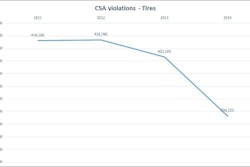By Robert Dieli, RDLB, Inc.
Those of us in the trucking sector know that there are always multiple forces at work behind trucking activity.
While most of our attention is devoted to the tangible measures of that activity, such as tonnage and mileage, we also need to keep track of the intangibles, such as the regulations that govern the movement of freight, and by extension, the movement of trucks. In the final analysis, it is the movement of the trucks that determines how much gets spent on the parts and service needed to keep them profitably in motion.
Over the past year we have had to contend with the effects of the labor dispute at the West Coast ports on the movement of goods in and out of those locations.
One thing we learned is that bottlenecks at the docks quickly affect the rest of the supply chain. And, just when we thought we had cleared up those backlogs and gotten back to a more normal contour of operations, along comes the International Maritime Organization (IMO) with a directive under the Safety of Life at Sea (SOLAS) convention requiring the certification of the true weight of all shipping containers before loading on to an ocean going vessel.
Under the directive, a document called a verified gross mass declaration (VGM) must be presented at the dock before a container can be loaded. The directive went into effect worldwide on July 1, 2016. Ship operators have been pushing for the VGM requirement for some time, as there have been several marine accidents stemming from improperly stated container weights.
The implementation of the VGM requirement is expected to be difficult both from a logistical standpoint (getting every container weighed and certified) and from a legal standpoint (who bears the final responsibility for the accuracy of the VGM?).
In the first case, many terminals here and abroad, are offering weighing services to help deal with the problem. In the second case, matters are much more unsettled. Especially since the regulation provides for steep fines in cases of noncompliance. Some carriers are putting the responsibility for the VGM on the shipper who is originating the cargo.
In other cases, the carrier is accepting the shipment and then doing the final certification at the port. And this leaves out those parts of the world where precise weighing of cargo has been the exception rather than the rule.
The IMO has sent a circular out to the port directors instructing them that some leniency in the enforcement of the VCM rule in the interests of maintaining port efficiency will be allowed. But eventually, the IMO expects the rule to be fully implemented.
What does all this mean for the U.S. trucking sector and the aftermarket?
At best, a brief period of adjustment as shippers and carriers incorporate the additional steps needed to get a container on a ship. In that case, we should be able to get back to monitoring the quantitative measures of trucking activity to assess the demand for parts and service.
At worst, a prolonged period of uncertainty where the supply chain gets backed up much as it did last year while the shippers, the carriers, the IMO and lawyers try to get things sorted out.
Robert F. Dieli is president and founder of RDLB, Inc. an economic research and management consulting firm based in Lombard, Ill. Bob regularly collaborates with MacKay & Company on economic publications as well as industry presentations such as HDAD.










